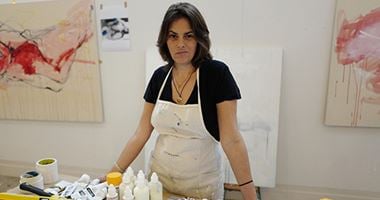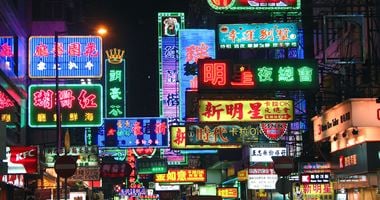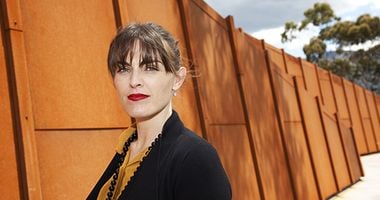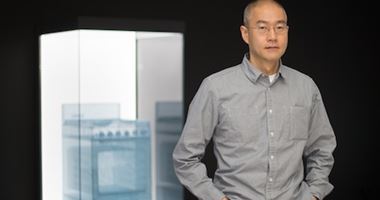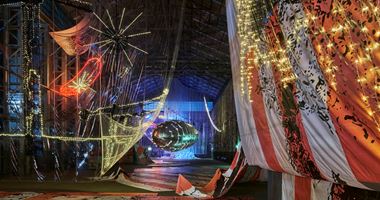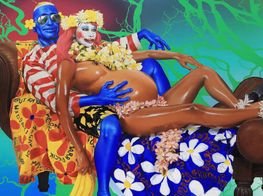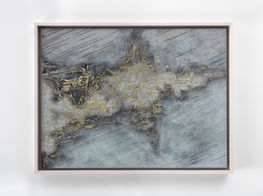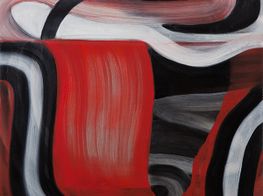Rachel Lehmann on Lehmann Maupin
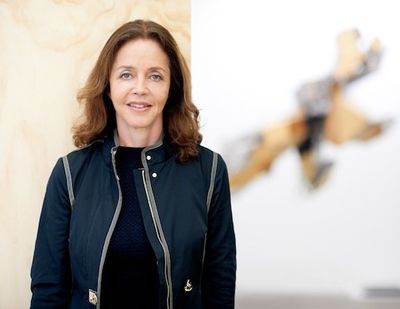
Rachel Lehmann is not only one half of the gallery powerhouse that is Lehmann Maupin, but she is also an international citizen of the world. Lehmann was born in Asmara, Ethiopia, and studied at the University of Fribourg in France. She worked at the legendary Sonnabend Gallery in New York, and was the proprietor of two contemporary galleries in Geneva and Lausanne, Switzerland, where she showed young artists, including Jeff Koons, who have since become international sensations.
Rachel Lehmann met David Maupin in Italy in 1991, and in 1993, she and David, in collaboration with Janelle Reiring and Helene Winer of Metro Pictures, established Offshore Gallery in East Hampton, where for two years artists such as Richard Prince, David Salle, and Ross Bleckner were exhibited. Three years later, in October 1996, Lehmann Maupin Gallery opened a space, which was designed by Rem Koolhaas, in New York's SoHo neighbourhood.
The gallery now has two spaces in New York, one in Chelsea and one in the Lower East Side. In March 2013, the gallery opened a third space in Hong Kong's Pedder Building. Lehmann Maupin represents both well-known artists such as Tracey Emin, Do Ho Suh and Gilbert & George, but was also an early supporter of talents such as Hernan Bas, Angel Otero and the Japanese artist Mr.
Lehmann has served on the International Council of the Solomon R. Guggenheim Museum, New York, and also on the Museum's Acquisitions Board. She has also been a member of the selection committee for the Art Dealer's Association of America. Rachel Lehmann spoke to Anna Dickie about being an outsider, the teacher who inspired her, what it takes to maintain a long working relationship, and her curiosity with Asia.
My parents told me many years earlier that I should do something more serious in my life.
ADI was very interested to read - and this is because I was also born in Africa - that you were born in Ethiopia?
RLAbsolutely! I was born actually in Asmara, which used to be part of Eritrea (and still is), but at the time Eritrea was part of Ethiopia—now of course Eritrea is independent. I was born 60 years ago when Eritrea was part of an Italian colony. I was in Asmara until the age of six. My father was German and at that time things were slowly changing in Ethiopia and following a regime change my parents returned to Europe, so I started my schooling years in Asmara, but then I went to school in Germany where I lived until I finished high school.
ADYour art career very much started in Switzerland though?
RLYes, that is right. I finished high school in Germany and then I went to Switzerland. But to be honest with you my first touch of contemporary art was in a very interesting way in Germany. The reason was simple. After the Second World War, the history of Germany kind of stopped in many different ways. I was however very lucky because I had a high school teacher who tried to give us something that was more connected in terms of history and life. So while I was growing up—when I was 14 to 16—I was taken by a very 'creative' high school teacher to see artist studios. I say creative because it is creative for a high school teacher to take children or young adults to artist studios rather than give them a backwards history lesson. Education can sometimes change your life and this was a life-changing experience for me.
ADWhat type of art was your teacher showing you?
RLIt was contemporary art. She was young and she was interested in local artists. We were in Frankfurt, but we were taking train trips—about an hour and a half —to visit artists in Cologne and Dusseldorf, because that is where the bigger academies were and there were lots of young artists living nearby. Sometimes it was Frankfurt, but once a week we were all looking forward to visiting the artist studios — well a lot of us were (of course you had the ones who were more interested in mathematics).
ADDid your parents encourage your interest in art at all?
RLNo, it definitely didn't come from home. My parents had a classical porcelain collection. My father actually collected porcelain work from the 18th Century—German porcelain. So he had very little to do with what I did later on.
ADHow did your parents view your involvement in contemporary art?
RLFor a very long time I was viewed as a marginal outsider and also a little bit as someone who didn't make sense at all. I experienced this for a much longer period than you would believe. My first gallery was in Switzerland and it is funny that you talk to me today because I am being honoured this week by the Swiss Institute for my contribution to art. And it is so interesting that it should happen in New York. When I opened my first gallery in Geneva it was the end of 1988 and I think people thought I was strange—nobody understood what I was doing.
My parents told me many years earlier that I should do something more serious in my life. 'You should be doing something that has to do with business', and this is why I studied political science and economics. I wanted to buy a drawing and they said, 'if you want anything, you should earn it first'; and so I sold shoes and I bought a drawing. I can remember it very clearly. But the first reaction to what I was doing in 1988, in 1990, even in 1993 was very, very cautious and very questioning. I don't really know what drew me to continue doing what I am doing. I am very fortunate to be part of the bigger art world today and I am very, very happy and I wouldn't be able to live another life — but I don't know what drew me to be so!
The other thing is that almost 99 per cent of our artists do not belong to groups.
ADYou obviously felt very much an outsider, but now you are an insider. You gave Jeff Koons one of his first exhibitions in Europe. That would have been incredibly brave at the time—particularly a show that featured work from the Made in Heaven series. It was controversial. Can you tell me about it?
RLIt was around 1991 that Made in Heaven was created. I, along with two other galleries, worked with Koons to produce an edition of three (which subsequently grew into a larger edition). At the time there were only three galleries involved—I was a gallery in Switzerland and there was also Sonnaband in New York—not the Gagosian that you know today—and there was Max Hetzler in Germany, which still exists. We produced this body of work with Koons. It was brave.
ADYou must have a sense of pride in taking the risks you took?
RLNo, I feel very, very lucky. I see it as a fortunate path. Now I am able to do whatever I want. I have the support I need in the artistic, art and international community. Humanly we tend to forget the very difficult times and I think we were lucky. If I was starting again today ... well we had less choices at the time. We had no internet connection.
Whatever we chose to do was a much bigger risk and it wasn't so easy to change your path—and this has advantages and disadvantages. As I get older and looking back I think it was an advantage for me at the time. You had no other choice—I could have had a very different life and perhaps worked for a large company but then had a life that was for me unacceptable. I did the only thing I could do. Today you have a lot of choices, connections and interfaces and it isn't always advantageous.
ADIt is interesting you mention a corporate life and the fact that you did politics and economics at university because in many ways Lehmann Maupin, as one of the major galleries in the world, has a very corporate structure. You have departments - sales, marketing, et cetera.
RLI think it isn't so corporate. We are a personal business that has grown with people. We work with living artists—who are obviously human and who we need to respect and we need to manage their careers too. We depend on people who work in our gallery to be able to provide that growth. I think what happens is that as you add people to organisations—whether it is a gallery, a bank or a small supermarket—you need to keep a little bit of structure so that you get the best results.
It is interesting that you asked me about the corporate structure. I think the biggest challenge today is to remain creative and to maintain support and stability at the same time. The core of what we are doing is remaining creative and remaining open to new discussions, ever evolving ideas and new worlds. The art world has an image of being very creative and very adventurous, but this is actually only one part of the equation. Stability is something we would like to provide to the artistic part of the equation and this allows the creative partner—the artist—room to explore. So in order to let an artist be creative, a gallery has to provide a stable home—and yes sometimes there has to be a little bit of a structure. We, as a gallery, have to be more conservative in order to provide this stability.
ADThe other characteristic I notice about Lehmann Maupin is one of long-term relationships. You and David Maupin have obviously had a very long relationship. You met in 1991 and have worked together ever since. You gave Tracey Emin one of her first shows in New York and you continue to work with her today. What do you think is the key to maintaining a long term working relationship with an artist?
RLIt is an interesting question. It is all about growing with an artist. A gallery has to grow at least as fast as the artist; but not just one artist—all of the artists that it works with.
The biggest risk a gallery can take is to be orientated to one single artist. The same is true about caring for one particular collector or collector type. I think being prolific and being open to opportunities and growing the business in terms of having more than one artist and growing with each artist you work with is very important.
A long time ago I was invited to an opening at Basel Switzerland. I was sitting next to the CEO of one of the big pharmaceutical companies in Switzerland. He said something that has stayed with me. He said: 'You know, you and me have the same problem'. I said: 'How can that be? You are a pharmaceutical company and your stock is quoted on the stock market and I am dealing with living artists.' He said: 'No, we have exactly the same issue. You are looking for creativity and you are looking for this ever-changing language. If I don't talk and I don't recognise the creative researcher, I don't have anything of interest in my pharmaceutical company.' So I think it is true that there is a need to maintain a balance between growth, stability and creativity.
Today you have a lot of choices, connections and interfaces and it isn't always advantageous.
ADIt is about a continuing curiosity I suppose. Lehmann Maupin opened its third space in Hong Kong's Pedder Building in 2013. That wasn't a sudden move. I understand you had been exploring art in Asia for some time before that. When did you first become curious about Asia?
RLThere were several things. Obviously I am an international citizen of the world: as you started the conversation with me you pointed to the fact I am born in Ethiopia and that makes me not pure Swiss, nor American. So that is the first thing. The second thing is that when we created Lehmann Maupin New York, which happened several years after Lehmann Maupin in Switzerland, many of my artists whom I represented in Switzerland were in fact already represented in New York—for example, Jeff Koons—and therefore I was looking for something new and creative. The other thing is that the basis of the gallery is representing contemporary artists from all over the world and managing those careers in New York.
I got very interested in Asia and that comes from a base of being international and creative and then also something happens that makes you realise the direction you need to go. So I remember visiting Yale in the United States and seeing a presentation of Do Ho Suh—as you know, a Korean artist—and then seeing a group show which featured Do Ho Suh, and that led me to my first trip to Korea.
So in 1999 we are exploring Do Ho Suh, who obviously is Korean but has a base in New York, and meeting him led me to Korea and that was my first business encounter with Asia and I immediately felt that we wanted to be more international. From Do Ho Suh we then went to Gilbert & George, who had a show at the time at a Museum in Asia—which has since closed—but was called the Toyota Museum and that led me to Japan. In Japan we visited a few artists at the time—for example [Takashi] Murakami that you know well—and that led me to the Kaikai Kiki group and now we are working with the Japanese artist Mr.
So it was a mixture of being curious and creative and also being open. Asia has a lot of interesting talent which was totally undiscovered at the time and at the time I was working with artists in America who were discovered, who were not unknown—so it was exciting and a new challenge.
Many people say to me: 'How did you know the world was going global?' I didn't know the world was going global and it wasn't the purpose of my interest. My purpose was simple; I wanted to work with interesting artists from all over the world, represent them in New York and manage their careers.
So I do feel deeply committed to Asia. There is an ever-growing energy and creativity. There is so much to do, so much art to discover. You mentioned about me being proud to have shown artists that were brave at the time—well I am as interested today to explore artists and cultures. In particular I am very interested in East Asia right now; there is a very interesting, creative and artistic vision emanating from this region which is particularly under explored in the United States, and also in Europe.
ADYour first exhibition in Hong Kong was with Lee Bul. Tell me about the decision to open the Hong Kong space?
RLWe are a little bit slow at Lehmann Maupin. We take decisions very seriously. We had been considering Korea, but there were several reasons we opened in Hong Kong. First, Art Basel was about to take over the Hong Kong art fair. The other reason was M+, which was starting to put grounds down, so Lars Nittve—whom I have known for a long time—was putting his structure together. And adding to this was also the location of Hong Kong and its geographical connections to Asia: to Taipei, to Singapore and China of course. It was also the universal use of English in Hong Kong. Hong Kong made more sense than Korea. We had worked with the museums in Japan, but we didn't think that was right.
The response has been interesting and good in Hong Kong. We have just come back on Sunday from FIAC art fair in Europe and you never know what the response will be and oddly the biggest response we had in FIAC, Paris was from Hong Kong-based collectors! I am very pleased and we have people working now for us in Hong Kong from several parts of Asia.
ADIs it correct you have appointed a new Director for the Hong Kong space?
RLYes. We appointed Li Yan as our Hong Kong Director as of today!
Li Yan is originally from Beijing, but will move to Hong Kong. In Hong Kong, Li Yan will work with Bo Kim from Korea, who is the associate director, and also Sheng Nien Yang, the associate sales director, who is from Taiwan. We have become in Hong Kong very Eastern orientated. I am very happy with the feedback and communication that we are having between Lehmann Maupin New York and Hong Kong. We have created an exchange of interns between Hong Kong and New York—last summer was the first summer. We are trying to create more of a dialogue between the two cities and an exchange of culture. We are learning a lot in New York and they are learning a lot in Asia too.
ADLet's talk about Art Taipei 2013, which opens on 8 November. Which artists will you be showing there?
RLAs you know it is the first time we are going to the Taipei art fair. Approaching art fairs is an example of the new global layers of complication. We need to think about each art fair differently—how are we going to provide the right view of the gallery, do we have the right artists working with us, the right inventory? This goes back to the importance of having in place good structures so that we can work to approach each art fair as well as we possibly can.
We will be showing a selection of the artists we show at Lehmann Maupin generally. We will be showing Robin Rhode, who is from South Africa and is known in Taipei in a very interesting way. We have already had several collectors collecting his work. We are going to be showing Tracey Emin. We will show Jennifer Steinkamp, who is an American artist of ours and who will be participating in the opening of Korea's National Museum—on the 12th of November. We will have the work of Do Ho Suh, who is also having a large installation at Korea's National Museum of Modern and Contemporary Art at the same time. We will have Lee Bul, who is our other Korean artist.
We are doing the same thing we do at every art fair. What we are trying to say is 'this is who we are; this is who we are trying to support'. We are not showing in Art Taipei anything that we wouldn't be showing at Art Basel Miami, FIAC or Armory. We are showing the artists we believe in and whose careers we manage.
ADIs there one characteristic that defines artists represented by Lehmann Maupin?
RLYes, all of our artists work in several medias. Even Hernan Bas does sculpture or video. We don't have artists who do only film—they also do drawing and painting. We are very interested in multi-layers of communication in all of our artists. Look for example at Liu Wei, who is a Chinese artist and is in a way one of the newest artists we have been working with; he works in sculpture, paintings and video. This is something that we like at Lehmann Maupin. We like artists who are creative in all medias.
The other thing is that almost 99 per cent of our artists do not belong to groups. They have a very individual approach, which is often conceptual or philosophical. The artist's message has to go beyond the group message. They have to have an individual voice. That is true for Emin, Do Ho Suh and all of our artists. —[O]



